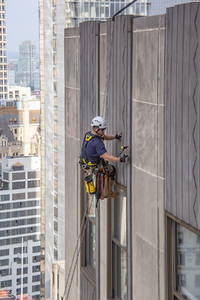 Rope access enables qualified building envelope professionals with specialized rope access certification to perform detailed inspections of hard-to-reach facade areas, ideal for meeting FISP requirements.
Rope access enables qualified building envelope professionals with specialized rope access certification to perform detailed inspections of hard-to-reach facade areas, ideal for meeting FISP requirements.
RAND’s Rope Access Facade Inspection Team
RAND’s certified Professional Rope Access Technicians perform close-range inspections of building facades and other exterior systems where conventional access methods, such as pipe scaffolding or suspended scaffolds, may be impractical or cost-prohibitive. Rope access allows for direct evaluation of exterior components for a variety of services, including Facade Inspection Safety Program (FISP) compliance, exterior condition surveys, leakage investigations, and construction monitoring. This method offers a safe, efficient, and minimally disruptive alternative for accessing complex or constrained areas of a building envelope.
Required Hands-On Inspections
FISP, formerly known as New York City Local Law 11/98, requires the facades of buildings taller than six stories to be inspected by a licensed engineer or architect every five years. A facade inspection report must be filed with the NYC Department of Buildings classifying the building as Safe, Safe With a Repair and Maintenance Program (SWARMP), or Unsafe. Under FISP, hands-on inspections must be performed at intervals of no more than 60 feet on street-facing and public-right-of-way facades. Additional hands-on inspections may be required if deemed necessary by the licensed professional for a comprehensive evaluation.
Motorized Scaffold Drops
Engineers and architects typically conduct hands-on inspections from a motorized scaffold hung from the roof. These inspections often require a full day to assemble the rigging, with the inspection itself taking place on a separate day. This process can be logistically challenging and time-consuming, especially on buildings with limited roof access or unusual configurations.
Faster Mobilization with Rope Access
Rope access systems require minimal equipment compared to traditional scaffolding or rigging and can often be mobilized within a few hours. This allows the inspection to be conducted the same day, reducing disruption and improving scheduling flexibility. Equipment can also be easily relocated to access multiple facades.
Less Intrusive Installation
Rope access is often the preferred method in situations where a motorized scaffold is not feasible, such as on buildings with sloped roofs, tight terraces, or irregular facade geometry. Additionally, building owners and residents may favor rope access because it avoids mounting large-scale equipment that can block views, reduce natural light, or pose security concerns.
More Comprehensive Inspections
Rope access allows inspectors greater flexibility to navigate complex or expansive facade areas. This mobility supports more thorough assessments of material conditions and deterioration, resulting in more accurate repair scopes and cost projections.
Cost Savings
The reduced setup time, minimal equipment needs, and greater flexibility of rope access can translate into significant cost savings, particularly for buildings requiring multiple hands-on inspection drops. These savings may increase when inspections span multiple facades.
Certified Facade Inspectors
RAND is authorized by the NYC Department of Buildings to perform rope access inspections and has a dedicated team of inspectors certified by the Society of Professional Rope Access Technicians (SPRAT). All inspections are overseen by Qualified Exterior Wall Inspectors (QEWIs) and licensed engineers and architects with deep experience in facade evaluations and NYC code compliance.
Contact RAND
To find out if your building would benefit from a FISP inspection or other facade evaluation using rope access, please contact RAND at 212-675-8844 or info@randpc.com.
